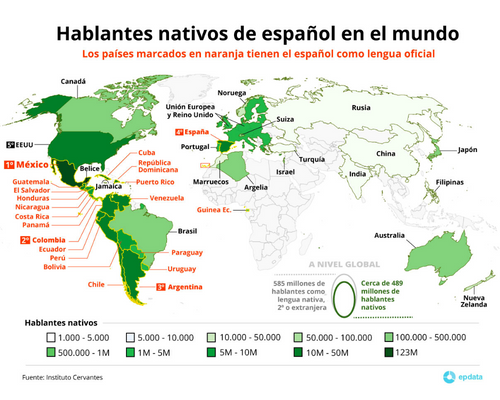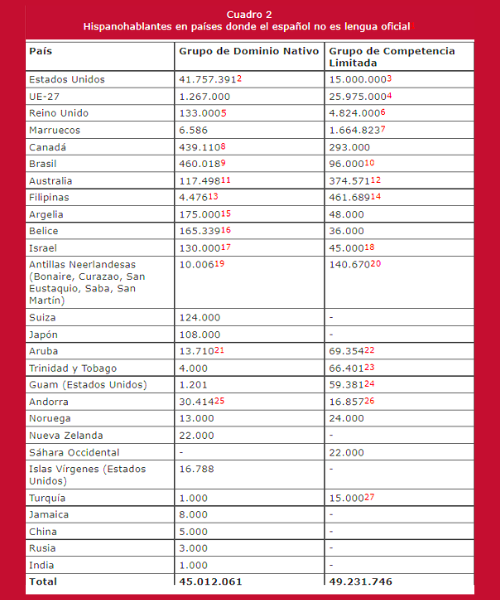The Spanish language in the world

Probably you have a general idea about which countries
have Spanish as an official language. Have you ever been curious about its position in the
ranking of the most spoken languages in the world? In this post we are going to talk about some facts related to Spanish speakers, learners and why there is such a big interest to learn Spanish among non-native speakers.
Wake up call for US businesses
According to an article published by Forbes in 2021, not only the various governments in the U.S. but also organizations and brands have already started to communicate in Spanish to their Spanish-speaking customers. The point of the article in Forbes is to remind brands that they should not risk missing their opportunity to expand their business, by not adjusting to their clients´ needs. In particular, by neglecting to communicate in their native language, in this case Spanish.
This positive turn towards the Spanish language in the U.S. is due to the fact that a total of 56.757.391 people in the U.S. are either native Spanish speakers or they speak Spanish as a second language. According to Forbes, 13 percent of the population speaks Spanish at home. It is the most common non-English language spoken in the U.S., which has the 2nd largest population of Spanish speakers in the world (Mexico has the largest).
Let´s have a look at how the Spanish language circulates around the world.

Foto 1: Hablantes nativos de español en el mundo
Spanish-speaking countries
Nowadays, there are 21 countries which have Spanish as the official language. Have a look at picture 1, here above, to find out which are those countries.
The number of native speakers in Spanish-speaking countries is headed by those countries with the largest population. Mexico, Colombia, Argentina and Spain are the ones that have the most, according to data from Instituto Cervantes.
It is interesting to note that in most of these countries other languages are also spoken that may be official too. Like in Spain, for example, where the other official languages are Basque, Galician and Catalan. However, the Spanish language works as the common tool to communicate with each other whenever you are a speaker of one of those other languages. The same occurs in other countries, like in Mexico, where the government acknowledges 68 languages, but the large majority of the population is monolingual in Spanish.
Are you crazy about figures? Check out then the table below. In this table you will find the exact number of Spanish speakers in each country according to the annual study made public by Instituto Cervantes.

Foto 2: Población de los países hispanohablantes
Non-Native Spanish speakers
Maybe you are wondering how many people, like you, are actually learning Spanish. Well, according to the statistics carried out by Instituto Cervantes, in 2021 there were more than 24 million students of Spanish all over the world.
As reported by Eurostat, 7% of the citizens in the EU speak Spanish as a foreign language. On top of that, more than six million students are actually learning Spanish in Europe. These statistics, since Brexit, do not include United Kingdom, where more than 5 million people also speak Spanish.
In the table below you can have a look at the number of Spanish speakers in countries where Spanish is not an official language.

Foto 3: Hispanohablantes en países donde el español no es lengua oficial
The happiness of speaking Spanish
After the figures and statistical data, we understand that if you learn Spanish, you will be able to communicate with a great deal of people. However, are numbers enough to show the gratification you obtain from learning the Spanish language? How about the happiness that you gain when speaking Spanish?
A study published by the National Academy of Sciences (you can find a review here) affirms that Spanish is the happiest language in the world… Well, this statement might look like an exaggeration… Let´s see…
Researchers from the University of Vermont collected and analysed billions of words from ten different languages and 24 sources of texts: social media, websites, books, etc. By means of using data mining techniques, the team of scientists located the 10,000 most used words in each of the ten languages. Afterwards, they selected native speakers to rate each of the words on a scale of 1 to 9 points based on the optimism that they reflected. They had to give a lower score to negative words.
The conclusions show:
1. Humans have a universal tendency to use positive/happy language.
2. Spanish is at the top of the ranking of positive/happy language use.
It is interesting to know that this study was part of a larger project to build a hedonometer, a sort of happiness meter. It is also interesting (or curious) to see what the
hedonometer says about the average level of happiness of Spanish tweets in Twitter. Perhaps, even more curious is to check the “average happiness” in the Spanish classic novel Don Quijote.
I hope you find this post interesting and remember: Be happy, speak Spanish!

